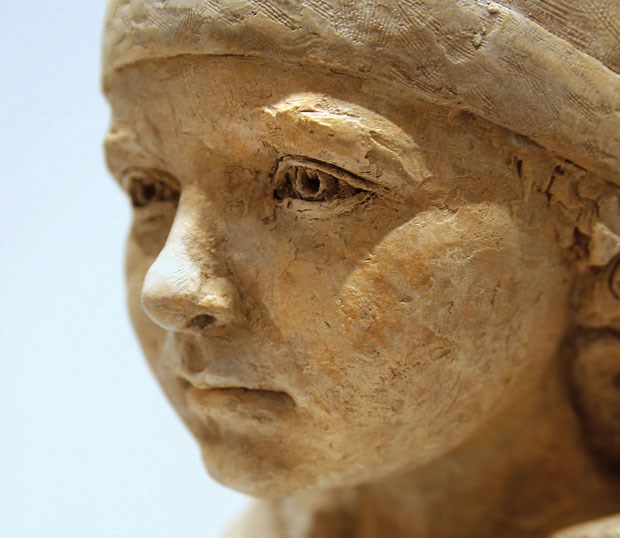Reinventing the Classics: Contemporary Responses to Old Master Prints, on now until Oct. 18 at Deep Cove's Seymour Art Gallery. seymourartgallery.com.
It was a pretty sweet gig for an art historian. On an average day Hilary Letwin, currently serving as Seymour Art Gallery's interim curator, would find herself tasked with pulling out anything from Michelangelo drawings to Beatrix Potter illustrations.
Working in London's British Museum prints and drawings department for just over two years starting in 2008 while completing her PhD in Italian Renaissance Prints at Baltimore's Johns Hopkins University, Letwin was continually enthralled by her unfettered access. "They give you a key to the cabinets," says the San Francisco native.
Letwin was grateful to have received a curatorial fellowship at the British Museum and then to have been able to stay on as a volunteer to help with cataloguing its Italian prints, which were being put online.
After living in the United Kingdom for 10 years, Letwin and her husband, an art historian and Lower Mainland native moved to Metro Vancouver in 2011, settling in Port Moody.
"We immediately recognized that there was very little pre-20th century European art in the greater Vancouver area. Certainly not in public art collections," says Letwin.
When given an opportunity to put together an exhibition at the Seymour gallery, she knew instantly what her area of focus would be. "I thought, there has to be a way to introduce some historical European, pre- 20th century art to some contemporary artists and see what happens," she says.
The resulting exhibition, Reinventing the Classics: Contemporary Responses to Old Master Prints, is on now until Oct. 18 at the Deep Cove gallery. The show opened Sept. 10 and features works by six diverse contemporary artists and their responses to two prints depicting classical art and architecture.
"The underlying principle of the exhibition is really to show our community and show our artists what can be gained from looking at historical art," says Letwin. The two prints are on loan from a local private collection and Letwin chose them, believing them to offer the perfect jumping off point.
"I thought with these two prints that there would be plenty of themes, and ideas and concepts that the six contemporary artists could grab on to," she says.
The older of the two prints is an engraving believed to have been made by Enea Vico and published in 1553 by prominent Rome Renaissance print publisher Antonio Lafreri, who was central to Letwin's PhD research. The print depicts a portrait bust of philosopher Aristotle, and claims to be accurate despite Aristotle's birth in approximately 348 B.C.
The more recent print dates back to 1756 and is an etching by Giovanni Battista Piranesi. It features Rome's Aqua Vergine aqueduct and is part of Piranesi's Roman Antiquities series.
"What they both have in common is that they demonstrate the artist's attempt at conflating time," says Letwin. Another commonality among the prints is that both were primarily intended as souvenirs for tourists visiting Rome.
Letwin handpicked artists she was confident would do something interesting with the concept. Their responses far exceeded her expectations. "There was an element of surprise with each of them," she says, adding she was also impressed by the amount of research they undertook.
"Each of the artists took a slightly different approach. Some of them were more formal and looked at the two prints and updated them. Others were a little bit more conceptual and took on some of the themes within the prints and even themes surrounding the things depicted, like the aqueduct and Aristotle," says Letwin. For example, with "Philosopher Dog," pen and ink artist Rose Kapp took the Aristotle print and created a similar profile of her canine Cheymus.
"She was really interested in this idea of animals thinking and dogs thinking and trying to figure out what they're thinking about," says Letwin. In contrast, sculptor and printmaker Gerri York was interested in Aristotle the philosopher and what he's written.
"He did some writing about man's relationship to nature and our responsibility to care for it and protect nature. She, in her regular practice, is very interested in nature conservation, water conservation specifically," says Letwin.
York decided to create resin spills, meant to resemble water, which were installed on the floor in the centre of the gallery. "It speaks not only to Aristotle's writing about water conservation but it also speaks to the aqueduct print because an aqueduct is all about controlling water and that's what she's doing with these very carefully poured spills," says Letwin.
Other contributors to Reinventing the Classics include: etcher Vahid Dastpak; ceramics artist Jeremy Hatch; North Vancouver contemporary abstract expressionist painter Joan Skeet; and sculptor Louise Solecki Weir.
Letwin is pleased with the success of the show and how gallery-goers of all ages have been responding. "It will be my long-term goal to bring historical European pre-20th century art to the Lower Mainland in whatever way possible, whether or not it's prints or something else," she says.
For those interested in learning more about the show, the gallery presents a free 20-minute curator's talk every Thursday at noon. In addition, staff have posted a related video, viewable on the gallery's website, seymourartgallery. com.
Next up, Seymour Art Gallery is presenting Art Party!, a fundraising exhibition and event in support of the space, Oct. 21 at 7 p.m.. Original artwork by more than 40 established and emerging local artists will be available at price points of $100, $200 or $300. The evening will also include live music, refreshments and dancing. The related exhibition will remain on display until Nov. 8.



